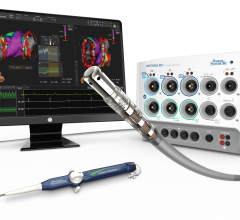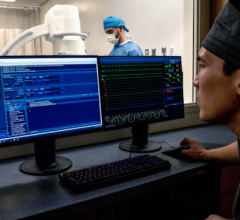Using GEâ??s Innova imaging system for central venous access and hemodialysis fistula management, Innova provides ...
Musculoskeletal injuries are of concern to many interventional radiologists due to the constant positioning, twisting ...
Dr. Frederic Deschamps of the Institut Gustavy Roussy, France, explains his use of the Innova TrackVision application to ...
Providing exceptional cardiovascular care for patients to achieve the best possible outcomes is the number one goal for ...
Dr. Thierry DeBaere of the Institut Gustave Roussy in Villejuif, France explains how he uses the GE Heathcare Innova ...
Prashant Patel, M.D., St. Luke's Hospital and Health Network, Bethleham, Pa., explains a case where he uses GE's Innova ...
March 22, 2011 - Further enhancing its cardiovascular reporting capabilities, Fujifilm Medical Systems Inc. added its Intelligent Structured Reporting (ISR) technology, an advanced software decision support system.
Cardiac positron emission tomography (PET) is growing in popularity among cardiologists because it provides the ability ...
March 22, 2011 – During complex interventional procedures, it is challenging to accurately navigate and interpret the vascular anatomy for precise device deployment. To aid physicians during such interventions, Toshiba America Medical Systems Inc. introduced Volume Navigation 3-D roadmapping for the Infinix-i vascular X-ray product line.
March 22, 2011 - Terumo Cardiovascular Systems (CVS) said it agreed to the terms of a consent decree with the U.S. Food and Drug Administration (FDA) regarding quality system improvements at the company's Ann Arbor, Mich., facility. The agreement will be subject to the approval of the United States District Court for the Eastern District of Michigan.
March 21, 2011 - Researchers have shown for the first time that stem cells injected into enlarged hearts reduced heart size, reduced scar tissue and improved function to injured heart areas, according to a small trial published in Circulation Research: Journal of the American Heart Association.
When performing radiofrequency (RF) ablation to treat cardiac arrhythmia, medical professionals must balance the safety ...
March 21, 2011 - OrbusNeich today announced it filed a lawsuit in the Netherlands against a doctor and principal investigator of a trial examining OrbusNeich's Genous coronary stent.
March 21, 2011 - A pilot study in healthy children and adolescents shows that it is feasible to screen for undiagnosed heart conditions that increase the risk of sudden cardiac arrest (SCA). Adding a 10-minute electrocardiogram (ECG) to a history and physical examination identified unsuspected cases of potentially serious heart conditions.

For more than 20 years, radiation oncologists have emphasized the importance of radiation-tolerant heart rhythm devices for use in patients who require cardiovascular regulation. In the last three years, interest has increased, as medical physicists responded to the U.S. Food and Drug Administration (FDA) to promote investigational research.
Change Healthcare Cardiology Hemodynamics is an integrated hemodynamic monitoring system for monitoring vital signs and ...

With the increased use of transradial cardiac catheterization throughout hospitals across the country, several results have become apparent. Transradial catheterization has been shown to have fewer bleeding complications, faster recovery time and improved patient satisfaction. It also offers a unique opportunity to improve resource utilization.
Transradial Approach (Left vs. Right) and Procedural Times During Coronary Procedures: TALENT study Alessandro Sciahbasi, et al. American Heart Journal, 2011, 161: 172-9 Study design: Prospective, randomized 1,467 patients (Jan. 2009-Dec. 2009) to right radial approach (RRA) or left radial approach (LRA).

Radial artery occlusion rate during transradial access procedures is strongly related to sheath and catheter size. Although worldwide most experienced practitioners (90 percent) use 5 and 6 French systems(1), high-quality coronary artery opacification can be obtained with 4 French systems.


 March 22, 2011
March 22, 2011









